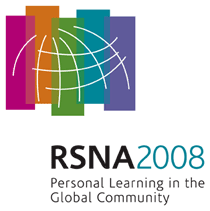
Abstract Archives of the RSNA, 2008
SSC18-03
Impact and Correction of Cross Scatter for Raw-data Based Material Decomposition in Dual-energy Dual Source CT (DE-DSCT)
Scientific Papers
Presented on December 1, 2008
Presented as part of SSC18: Physics (CT: Dual Energy)
Yiannis Kyriakou PhD, Presenter: Nothing to Disclose
Christian Reinhart Dipl Phys, Abstract Co-Author: Nothing to Disclose
Willi A. Kalender PhD, Abstract Co-Author: Consultant, Siemens AG
Founder, VAMP GmbH
Scientific Advisor, VAMP GmbH
Shareholder, VAMP GmbH
The acquisition in DE-DSCT is affected by cross scatter from the second tube-detector system arranged at 90°. Low energy primary photons registered at one detector are superimposed by high energy cross scattered photons and vice versa. We evaluated the impact of cross scatter and a respective correction algorithm on the accuracy of basis material decomposition in DE-DSCT.
Measurements of cross scatter were performed using a dual source scanner (Somatom Definition, Siemens, Forchheim, Germany) by switching one tube off, but still reading out the corresponding detector using 140 kV and 80 kV for the high and low energy source, respectively. The mAs-ratios (low-energy mAs to high-energy mAs) ranged from 0.5 to 5 for PMMA phantoms of 16 and 32 cm diameter. A dedicated cross scatter correction algorithm was implemented based on look-up tables which were generated by measurement as a function of tube voltage and object size using tissue-equivalent phantoms ranging from thin to obese. Look-up table interpolation was applied to gain the corresponding cross scatter estimate for arbitrary objects. A raw-data-based dual energy (DE) basis material decomposition was used for the generation of material-selective images of anthropomorphic phantoms containing soft-tissue and bone-equivalent inserts. We compared the accuracy of the CT images (80 and 140 kV) as well as the material density images for water and calcium with and without scatter correction. A DE scan using two separate single source scans was chosen as the reference.
The outer dimensions of the phantom and the mAs-ratio were decisive for the impact of cross scatter. Regarding the low-energy image, an mAs-ratio of 1 lead to a scatter fraction increase of above 300% as compared to an mAs-ratio of 4. Scatter correction provided a reduction of artifacts but locally increased image noise as a function of the cross scatter fraction. The average deviation of the resulting water and calcium density values to the reference values decreased from 50-200% down to 5-25% (depending on the evaluated region) when applying the correction.
Cross scatter in DE-DSCT may cause artifacts and errors in the calculation of material-selective images, but can be corrected to a large degree.
The impact of cross scatter on dual energy decomposition cannot be neglected with respect to quantification evaluation of tissue parameters.
Kyriakou, Y,
Reinhart, C,
Kalender, W,
Impact and Correction of Cross Scatter for Raw-data Based Material Decomposition in Dual-energy Dual Source CT (DE-DSCT). Radiological Society of North America 2008 Scientific Assembly and Annual Meeting, February 18 - February 20, 2008 ,Chicago IL.
http://archive.rsna.org/2008/6011361.html

